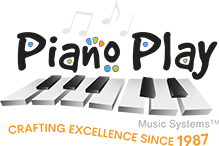Grades 1-4
Piano Lessons Designed for Children 6 to 9 Years Old
An Entertaining Approach to Learning Music
for the Older Beginner!
Piano Lessons for 1st and 2nd Graders
Piano Lessons Designed for Children 6 to 8 Years Old

The Roofuss Reports program explore music fundamentals in an entertaining way.
Roofuss Reports introduces a heroic boy named Roofuss. This character is the center of this unique year-and-a-half program. Students will learn to sing songs expressively and play and read music appropriately for older students. Students will work on rhythmic notation, ear training, and music theory each week. This upbeat class is exciting and will keep your school-age child wanting more.
Piano Playing Lessons:
- Each book takes 20-weeks / 5 months to complete.
- All classes have no more than 6 students per class.
- Classes meet for 50-minutes.
- A Group Recital is held after the completion of each book.
Our uniquely designed Layered Learning Environment (LLE)® process helps Roofuss Reports students to:
- Exercise abstract thinking
- Self monitor
- Cooperate in groups
- Expand imaginative play
Roofuss Reports Book 1 Piano Classes
The Roofuss classes are designed to stimulate the interest in the music of school-age children. The older beginners will learn to read and play treble and bass clefs using two hands by the end of the semester. Ear training, expressive singing, rhythmic notation, and written music theory are taught each week in exciting and innovative ways.
Music goals for book 1:
- Introduction of finger exercises using do, re, mi, fa, and sol with both hands
- Introduction of reading notes do, re, mi, fa, and sol in treble and bass clefs
- Simple rhythm notation
- Introduction to basic music theory and terms
- Introduction to music articulation and dynamics
- Ear training and expressive singing based on do, re, mi, fa, and sol
Roofuss Reports 2 & 3 Piano Classes (*Prerequisite Book 1)
Roofuss book 2 takes students on more exciting adventures while being challenged with more difficult rhythmic patterns, harmonization, keyboard playing, keyboard ensemble playing and ear training. In this advanced book, students reinforce previous fundamental skills while being introduced to minor modes and accidents in two Major keys. Roofuss Reports 3 is the last book of this series. This book develops song analysis, transposition, advanced rhythms, chord playing, and playing songs in three keys, Do, Sol, and Fa.
Music goals for Roofuss Report book 2:
- More advanced note reading and playing in treble and bass clefs
- Music notation in treble and bass clefs
- Music analysis
- Chordal playing
- Introduction to song transposition
- Recognition of singing patterns using do, re, mi, fa, sol, la, and ti
- More advanced music and rhythm terms
- Recognition of two phrases by ear in two Major keys.
- More challenging ear training, music theory, and rhythm patterns
Music goals for Roofuss Report book 3:
- More advanced note reading and playing in Major and minor keys
- Music notation in treble and bass clefs
- Music analysis
- Chordal playing
- Singing two and four-measure patterns by ear using do, re, mi, fa, sol, la, and ti
- More advanced music and rhythm terms
- Expressive singing using do, re, mi, fa, and sol
- More advanced music theory and rhythm patterns
The successful completion of book 3 will enable students to continue to private lessons at a comparative piano level of 1 or higher.
Contact us to learn more about Piano Lessons in Sherman Oaks and Pasadena and about our unique piano playing and teaching method at Piano Play Music Systems!
Roofuss Reports piano classes in Sherman Oaks and Pasadena.
Piano Lessons for 3rd – 4th Graders
Piano Lessons Designed for Children 8 and 9 years old
The Music Seekers program keeps the older child’s interest by teaching them specific skills in a fun way!
The Music Seekers series takes two 20-week semesters to complete. This fast, fun, quick-paced 50-minute class was created with a private lesson approach to teaching older beginners students who have never had a piano lesson. Students learn to read and play songs using both hands in three Major keys. In addition, students will have weekly ear training and sight singing exercises, finger technique, and written theory. It is not mandatory for parents or guardians to stay in classes but are welcome.
There are two method books and two activity books in the Music Seekers series. Students must have a 4 to 5-octave touch-sensitive keyboard or piano for home use for all students on this course. A group recital is held after the completion of each book.
Music Seeker in Sherman Oaks and Pasadena.
Music Seekers Book 1 and 2 Piano Classes
Goals for Music Seekers book 1:
- Introduction to ensemble playing
- Present two Major keys in both treble and bass clef
- Introduction to music analysis and music theory
- Expressive singing using do, re, mi, fa, and sol
- Introduction to music notation and analysis
- Ear training using do, re, mi, fa, and sol
Goals for Music Seekers book 2:
- More advanced keyboard skills in Major and minor keys
- Advanced note reading and rhythm understanding
- Advanced chordal playing and music theory
- Singing two and four-measure patterns by ear using do, re, mi, fa, sol, la, and ti
- More advanced music and rhythm terms
- Expressive singing using do, re, mi, fa, and sol
- More advanced music theory and rhythm patterns
After this book, students are encouraged to continue playing private lessons at piano level two. Students are assigned theory homework each week and technique exercises.




